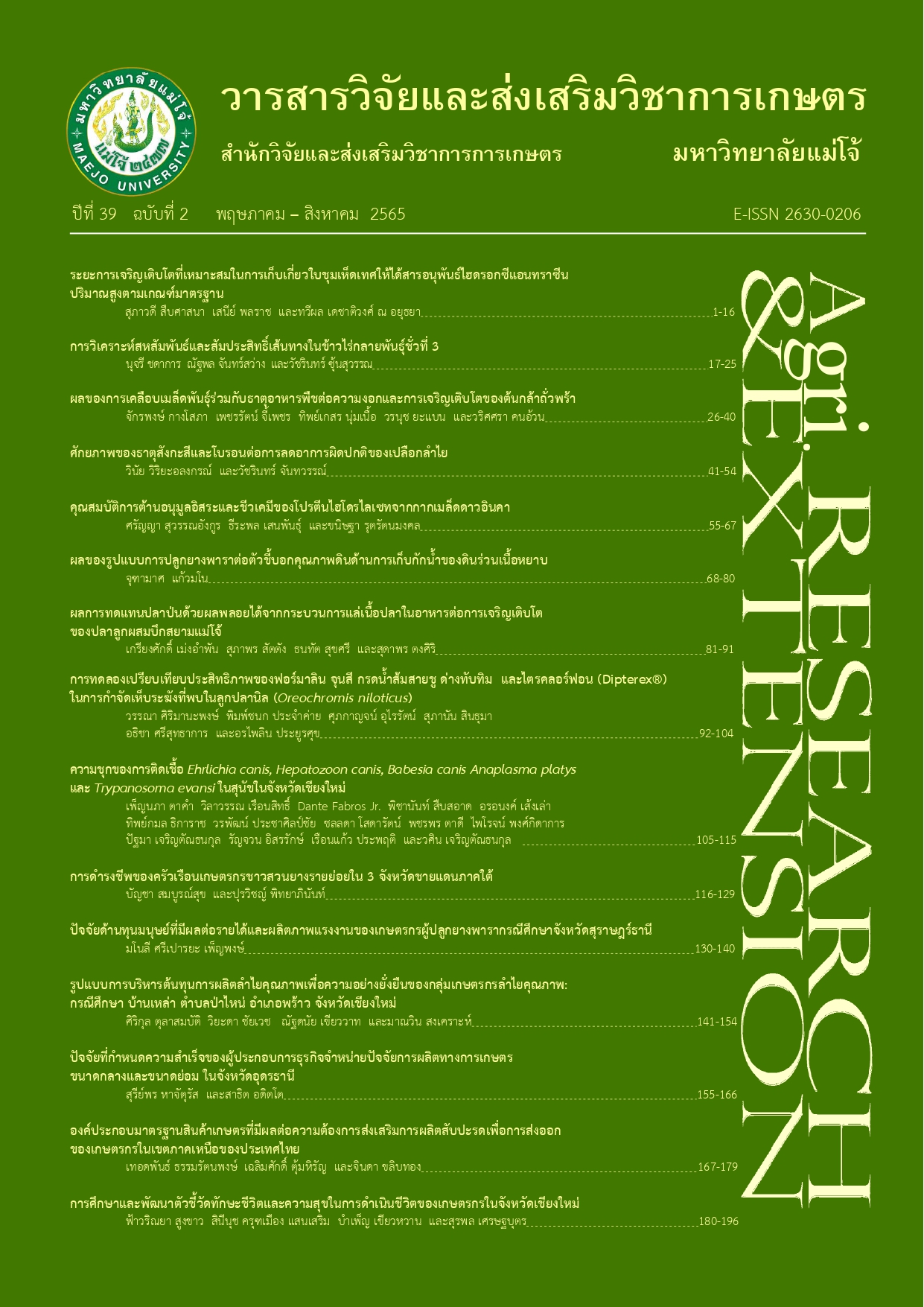ความชุกของการติดเชื้อ Ehrlichia canis, Hepatozoon canis, Babesia canis Anaplasma platys และ Trypanosoma evansi ในสุนัขในจังหวัดเชียงใหม่
คำสำคัญ:
ความชุก , พยาธิในเลือด , สุนัข, เชียงใหม่ , ปฏิกิริยาลูกโซ่โพลิเมอเรสแบบมัลติเพล็กซ์บทคัดย่อ
การศึกษานี้มีวัตถุประสงค์เพื่อสำรวจการติดเชื้อก่อโรคพยาธิในเลือดในสุนัขในจังหวัดเชียงใหม่ โดยใช้ปฏิกิริยาลูกโซ่โพลิเมอเรสแบบมัลติเพล็กซ์ที่พัฒนาขึ้นในห้องปฏิบัติการ และเพื่อใช้เป็นฐานข้อมูลในการให้บริการทางสัตวแพทย์ของคณะสัตวแพทยศาสตร์ มหาวิทยาลัยแม่โจ้ ทำการเจาะเก็บตัวอย่างเลือดสุนัขจำนวน 870 ตัว จาก 19 อำเภอ นำมาตรวจหาสารพันธุกรรมของยีน VirB9 ของเชื้อ Ehrlichia canis ยีน 18S rRNA ของเชื้อ Hepatozoon canis และ Babesia canis และยีน groEl ของเชื้อ Anaplasma platys ด้วยปฏิกิริยาลูกโซ่ โพลิเมอเรสแบบมัลติเพล็กซ์ และยีน VSG ของเชื้อ Trypanosoma evansi ด้วยปฏิกิริยาลูกโซ่โพลิเมอเรส พบสุนัขติดเชื้อ H. canis มากที่สุด (331 ตัว: ร้อยละ 56.7) รองลงมาคือ E. canis (6 ตัว: ร้อยละ 1) A. platys (5 ตัว: ร้อยละ 0.9) และ B. canis (2 ตัว: ร้อยละ 0.3) ตามลำดับ สุนัขบางตัวติดเชื้อตั้งแต่ 2 ชนิดขึ้นไป ได้แก่ H. canis + B. canis (191 ตัว: ร้อยละ 32.7) รองลงมาคือ E. canis + H. canis (15 ตัว: ร้อยละ 2.6) H. canis + A. platys (12 ตัว: ร้อยละ 2.1) E. canis + H. canis + B. canis (8 ตัว: ร้อยละ 1.4) H. canis + B. canis + A. platys (8 ตัว: ร้อยละ 1.4) E. canis + H. canis + A. platys (2 ตัว: ร้อยละ 0.3) และ E. canis + H. canis + B. canis + A. platys (4 ตัว: ร้อยละ 0.7) ไม่พบการติดเชื้อ T. evansi ในสุนัขทั้งหมดที่ศึกษา การติดเชื้อก่อโรคพยาธิในเลือด ไม่มีความสัมพันธ์กับเพศและช่วงอายุของสุนัข แต่มีความสัมพันธ์อย่างมีนัยสำคัญทางสถิติกับการมีหน่วยบริการทางสัตวแพทย์ใกล้บ้านในระยะ 10 กิโลเมตร
เอกสารอ้างอิง
Baneth, G. 2011. Perspectives on canine and feline hepatozoonosis. Veterinary Parasitology 181(1): 3-11.
Baneth, G., S. Harrus, A. Gal and I. Aroch. 2015. Canine vector-borne co-infections: Ehrlichia canis and Hepatozoon canis in the same host monocytes. Veterinary Parasitology 208(1): 30-34.
Carrade, D.D., J.E. Foley, D.L. Borjesson and J.E. Sykes. 2009. Canine granulocytic anaplasmosis: a review. Journal of Veterinary Internal Medicine 23: 1129-1141.
Chomel, B. 2011. Tick-borne infections in dogs-an emerging infectious threat. Veterinary Parasitology 179(4): 294-301.
Jittapalapong, S., O. Rungphisutthipongse, S. Maruyama, J.J. Schaefer and R.W. Stich. 2006. Detection of Hepatozoon canis in stray dogs and cats in Bangkok, Thailand. Annals of the New York Academy of Sciences 1081: 479-488.
Juasook, A., T. Boonmars, P. Sriraj, R. Aukkanimart, T. Jitjuk, P. Sudsarn and W. Maleewong. 2016. Prevalence of tick-borne pathogens in quarantined dogs at Nakornpranom animal quarantine station, Thailand. Journal of Mahanakorn Veterinary Medicine 11(1): 1-9.
Laummaunwai, P., P. Sriraj, R. Aukkanimart, T. Boonmars, S. Boonjaraspinyo, S. Sangmaneedet, P. Potchimplee, P. Khianman and W. Maleewong. 2014. Molecular detection and treatment of tick-borne pathogens in domestic dogs in Khon Kaen, Northeastern Thailand. The Southeast Asian Journal of Tropical Medicine and Public Health 45(5): 1157-1166.
Little, S.E. 2010. Ehrlichiosis and anaplasmosis in dogs and cats. Veterinary Clinics of North America; Small Animal Practice 40(6): 1121-1140.
Liu, M., N. Ruttayaporn, V. Saechan, C. Jirapattharasate, P. Vudriko, P.F.A. Moumouni and H. Suzuki. 2016. Molecular survey of canine vector-borne diseases in stray dogs in Thailand. Parasitology International 65(4): 357-361.
Nithikadpanich, C., P. Takam and W. Charerntantanakul. 2019. Development of multiplex polymerase chain reaction for simultaneous detection of Ehrlichia canis, Hepatozoon canis and Babesia canis in canine blood. Journal of Agricultural Research & Extension 36(2): 80-90. [in Thai]
Pantchev, N., S. Pluta, E. Huisinga, S. Nather, M. Scheufelen, M.G. Vrhovec, A. Schweinitz, H. Hampel and R.K. Straubinger. 2015. Tick-borne diseases (Borreliosis, Anaplasmosis, Babesiosis) in German and Austrian dogs; status quo and review of distribution, transmission, clinical findings, diagnostics and prophylaxis. Parasitology Research 114(Suppl.1): S19-54.
Piratae, S., K. Pimpjong, K. Vaisusuk and W. Chatan. 2015. Molecular detection of Ehrlichia canis, Hepatozoon canis and Babesia canis vogeli in stray dogs in Mahasarakham province, Thailand. Annals of Parasitology 61(3): 183-187.
Piratae, S., P. Senawong, , P. Chalermchat, W. Harnarsa and B. Sae-chue. 2019. Molecular evidence of Ehrlichia canis and Anaplasma platys and the association of infections with hematological responses in naturally infected dogs in Kalasin, Thailand. Veterinary World 12(1): 131.
Ravindran, R., J.R. Rao, A.K. Mishra, K.M.L. Pathak, N. Babu, C.C. Satheesh and R. Rahul. 2008. Trypanosoma evansi in camels, donkeys and dogs in India: comparison of PCR and light microscopy for detection. Veterinarski Arhiv 78: 89-94.
Skotarczak, B. 2003. Canine ehrlichiosis. Annals of Agricultural and Environmental Medicine 10: 137-141.
Solano-Gallego, L., A. Sainz, X. Roura, A. Estrada-Peña and G. Miró. 2016. A review of canine babesiosis: the European perspective. Parasites & Vectors 9(1): 336.
Suksawat, J., Y. Xuejie, S.I. Hancock, B.C. Hegarty, P. Nilkumhang and E.B. Breitschwerdt. 2001. Serologic and molecular evidence of coinfection with multiple vector-borne pathogens in dogs from Thailand. Journal of Veterinary Internal Medicine 15(5): 453-462.
ดาวน์โหลด
เผยแพร่แล้ว
รูปแบบการอ้างอิง
ฉบับ
ประเภทบทความ
สัญญาอนุญาต
ลิขสิทธิ์ (c) 2022 วารสารวิจัยและส่งเสริมวิชาการเกษตร

อนุญาตภายใต้เงื่อนไข Creative Commons Attribution-NonCommercial-NoDerivatives 4.0 International License.
บทความนี้ได้รับการเผยแพร่ภายใต้สัญญาอนุญาต Creative Commons Attribution-NonCommercial-NoDerivatives 4.0 International (CC BY-NC-ND 4.0) ซึ่งอนุญาตให้ผู้อื่นสามารถแชร์บทความได้โดยให้เครดิตผู้เขียนและห้ามนำไปใช้เพื่อการค้าหรือดัดแปลง หากต้องการใช้งานซ้ำในลักษณะอื่น ๆ หรือการเผยแพร่ซ้ำ จำเป็นต้องได้รับอนุญาตจากวารสาร





